Failure Analysis for Hydraulic System of Heavy-Duty Machine Tool with Incomplete Failure Data
Abstract
1. Introduction
2. Fault Tree Analysis Method Combining Incomplete Failure Data and Experts’ Opinions
- Model definition: System description, confirm the components of equipment, problem identification.
- Hazard analysis: Obtain the failure mode for components of the system.
- Fault tree construction: Identify the top event, Bes, and sub-events, then build up a fault tree according to the logical relationship.
- Qualitative analysis: Obtain the minimal cut sets.
- Quantitative analysis: Calculate the frequencies of BEs using failure data, then calculate the occurrence and importance measure of BEs.
- Risk assessment and control: Make decisions based on the results of the analysis and improve the reliability of the system.
2.1. Occurrence Calculation
2.1.1. Objective Occurrence Calculation Based on the Dempster–Shafer Evidence Theory
2.1.2. Subjective Occurrence Estimation Based on Rough Set Theory
2.1.3. Fusion of the Objective Occurrence and Subjective Occurrence
2.2. Importance Analysis
3. A Case Study
3.1. Fault Tree Construction
3.2. Quantitative Analysis
3.3. Importance Analysis and Decision Making
4. Conclusions
Author Contributions
Funding
Conflicts of Interest
References
- Uriarte, L.; Zatarain, M.; Axinte, D.; Yagüe-Fabra, J.; Ihlenfeldt, S.; Eguia, J.; Olarra, A. Machine tools for large parts. CIRP Ann.-Manuf. Technol. 2013, 62, 731–750. [Google Scholar] [CrossRef]
- Zhou, Z.-D.; Gui, L.; Tan, Y.-G.; Liu, M.-Y.; Liu, Y.; Li, R.-Y. Actualities and Development of Heavy-Duty CNC Machine Tool Thermal Error Monitoring Technology. Chin. J. Mech. Eng. 2017, 30, 1262–1281. [Google Scholar] [CrossRef]
- Urbikain, G.; Campa, F.-J.; Zulaika, J.-J.; López De Lacalle, L.-N.; Alonso, M.-A.; Collado, V. Preventing chatter vibrations in heavy-duty turning operations in large horizontal lathes. J. Sound Vib. 2015, 340, 317–330. [Google Scholar] [CrossRef]
- Prodan, D.; Balan, E.; Bucuresteanu, A.; Constantin, G. Hydraulic balancing of crossrails and rams of heavy duty machine tools. Proc. Manuf. Syst. 2015, 10, 3–8. [Google Scholar]
- Zhang, F.; Cheng, L.; Gao, Y.; Xu, X.; Wang, Y. Fault tree analysis of a hydraulic system based on the interval model using latin hypercube sampling. J. Intell. Fuzzy Syst. 2019, 37, 8345–8355. [Google Scholar] [CrossRef]
- Urreta, H.; Aguirre, G.; Kuzhir, P.; Lopez de Lacalle, L.-N. Seals Based on Magnetic Fluids for High Precision Spindles of Machine Tools. Int. J. Precis. Eng. Manuf. 2018, 19, 495–503. [Google Scholar] [CrossRef]
- Xiong, Y.; Wu, J.; Deng, C.; Wang, Y. Machining process parameters optimization for heavy-duty CNC machine tools in sustainable manufacturing. Int. J. Adv. Manuf. Technol. 2013, 18, 1–10. [Google Scholar] [CrossRef]
- Dobrivoje, C.; Milomir, G.; Mile, S.; Jasna, G. Fault tree analysis of hydraulic power-steering system. Int. J. Veh. Des. 2014, 64, 26–45. [Google Scholar] [CrossRef]
- Shafiee, M.; Enjema, E.; Kolios, A. An Integrated FTA-FMEA Model for Risk Analysis of Engineering Systems: A Case Study of Subsea Blowout Preventers. Appl. Sci. 2019, 9, 1192. [Google Scholar] [CrossRef]
- Baklouti, A.; Nguyen, N.; Mhenni, F.; Choley, J.-Y.; Mlika, A. Improved Safety Analysis Integration in a Systems Engineering Approach. Appl. Sci. 2019, 9, 1246. [Google Scholar] [CrossRef]
- Hyun, K.-C.; Min, S.; Choi, H.; Park, J.; Lee, I.-M. Risk analysis using fault-tree analysis (FTA) and analytic hierarchy process (AHP) applicable to shield TBM tunnels. Tunn. Undergr. Space Technol. 2015, 49, 121–129. [Google Scholar] [CrossRef]
- Sung, B.J.; Kim, D.S. A study of reliability improvement of high capacity cooling system for machine tool. In Proceedings of the 2014 17th International Conference on Electrical Machines and Systems, ICEMS, Hangzhou, China, 22–25 October 2014; pp. 2396–2402. [Google Scholar] [CrossRef]
- Zhou, L.; Chen, S.; Liang, Y.; Cheng, K. Reliability design of machine tool feed system based on fault tree analysis. Mach. Des. Manuf. 2007, 6, 60–62. [Google Scholar]
- Fan, J.; Wang, H.; Zhang, L.; Liu, C. FMECA and FTA Reliability Analysis of Head Frame System of CNC Grinding Machine. Modul. Mach. Tool Autom. Manuf. Technol. 2016, 11, 157–160. [Google Scholar] [CrossRef]
- Mi, J.; Li, Y.; Peng, W.; Yang, Y.; Huang, H.-Z. Fault tree analysis of feeding control system for computer numerical control heavy-duty horizontal lathes with multiple common cause failure groups. J. Shanghai Jiaotong Univ. 2016, 21, 504–508. [Google Scholar] [CrossRef]
- Zhang, Y.; Fan, J.; Li, Z.; Wu, C.; Tao, H.; Zhao, Y.; Lu, Q. Reliability analysis of cooling system of CNC grinding machine based on FTA analysis. IOP Conf. Ser. Mater. Sci. Eng. 2019, 612, 1–9. [Google Scholar] [CrossRef]
- Patil, R.B.; Mhamane, D.A.; Kothavale, P.B.; Kothavale, B. Fault Tree Analysis: A Case Study from Machine Tool Industry. In Proceedings of the TRIBOINDIA-2018 An International Conference on Tribology, Mumbai, India, 13–15 December 2018. [Google Scholar] [CrossRef]
- Hogan, P.A.; Burrows, C.R.; Edge, K.A.; Atkinson, R.M.; Montakhab, M.R.; Woollons, D.J. Automated fault tree analysis for hydraulic systems. J. Dyn. Sys. Meas. Control. 1996, 118, 278–282. [Google Scholar] [CrossRef]
- Shen, G.; Li, H.; Zhang, Y.; Li, Q.; Wang, X.; Ding, Y. The importance analysis of tool magazine fault and its reliability improved design. J. Chongqing Univ. 2013, 36, 70–75. [Google Scholar]
- Ma, C.; Wang, K.; Sun, J. Fault diagnosis to mid-size excavator hydraulic system based on fault tree analysis. In Proceedings of the 2010 International Conference on Frontiers of Manufacturing and Design Science, Chonqqing, China, 11–12 December 2010; pp. 1110–1114. [Google Scholar] [CrossRef]
- Jianghong, S.; Chi, M.; Yuanlin, Y. Fault diagnosis to mid-size excavator bucket hydraulic system based on fault tree analysis. In Proceedings of the 3rd International Conference on Digital Manufacturing and Automation, Guilin, China, 31 July–2 August 2012; pp. 88–92. [Google Scholar] [CrossRef]
- Purba, J.H.; Lu, J.; Zhang, G.; Pedrycz, W. A fuzzy reliability assessment of basic events of fault trees through qualitative data processing. Fuzzy Sets Syst. 2014, 243, 50–69. [Google Scholar] [CrossRef]
- Ferdous, R.; Khan, F.; Sadiq, R.; Amyotte, P.R.; Veitch, B. Handling data uncertainties in event tree analysis. Process. Saf. Environ. Prot. 2009, 87, 283–292. [Google Scholar] [CrossRef]
- Mi, J.; Li, Y.; Li, H.; Huang, H. Fault tree analysis for CNC hydraulic system based on fuzzy theory. Manuf. Tech Mach. Tool 2011, 4, 114–119. [Google Scholar] [CrossRef]
- Ren, Y.; Ding, Z.; Li, D.; Yu, J.; Liu, Y.; Yu, K.; Zhan, G. Research on Fuzzy Fault Tree Analysis for Hydraulic System of A-Frame Launch & Recovery System for the “Jiaolong” Manned Submersible. Zhendong Ceshi Yu Zhenduan 2018, 38, 1187–1192, 1293. [Google Scholar] [CrossRef]
- Li, Y.; Sun, J.; Li, H.; Huang, H.-Z.; Liu, Y. Fuzzy dynamic fault tree analysis of hydraulic system of CNC machining center. In Proceedings of the ASME 2011 International Design Engineering Technical Conferences and Computers and Information in Engineering Conference, Washington, DC, USA, 28–31 August 2011; pp. 887–892. [Google Scholar] [CrossRef]
- Li, Q.; Sun, H.; Chen, X. Reliability Analysis of Hydraulic System of Anchor Drilling Rigs Based on Fuzzy Fault Tree. J. Donghua Univ. 2019, 36, 227–233. [Google Scholar] [CrossRef]
- Zhang, L.L.; Zhang, R.J.; Si, X.X. Importance analysis method of fuzzy fault tree based on T-S modle and application in hydraulic system. In Proceedings of the 2nd International Conference on Mechanical Engineering, Materials Science and Civil Engineering, Beijing, China, 25–26 October 2013; pp. 707–711. [Google Scholar] [CrossRef]
- Zheng, P.; Xu, X.; Xie, S. A weighted interval rough number based method to determine relative importance ratings of customer requirements in QFD product planning. J. Intell. Manuf. 2019, 30, 3–16. [Google Scholar] [CrossRef]
- Mansour, B.; Mahmoud, M.; Naser, S. Fuzzy reliability analysis using a new alpha level set optimization approach based on particle swarm optimization. J. Intell. Fuzzy Syst. 2016, 30, 235–244. [Google Scholar] [CrossRef]
- Zhang, Z.; Jiang, C.; Fan, S.; Liu, J. A reliability-based design optimization method for structures using evidence theory. Sci. Sin. Technol. 2016, 46, 706–716. [Google Scholar] [CrossRef]
- Xi, Z.; Linghu, Q.; Yi, C.; Wu, X.; Li, J.; Tang, Z. A novel combination of evidence theory based on improved conflict coefficient. J. Cent. South Univ. Sci. Technol. 2018, 49, 1700–1709. [Google Scholar] [CrossRef]
- Khoo, L.P.; Tor, S.B.; Zhai, L.Y. A Rough-Set-Based Approach for Classification and Rule Induction. Int. J. Adv. Manuf. Technol. 1995, 15, 438–444. [Google Scholar] [CrossRef]
- Wang, X.; Lv, S. Multi-attribute Decision Method Based on Interval Rough Numbers Considering the Risk Preferences of Decision-makers. Stat. Decis. 2017, 10, 50–53. [Google Scholar] [CrossRef]
- Li, D.; Zeng, W.; Zeng, W. Novel ranking method of interval numbers based on the Boolean matrix. Soft Comput. 2016, 31, 629–634. [Google Scholar] [CrossRef]
- Zhang, G.; Zhang, H.; Pang, J.; Liu, J. Fault trace and analysis of hydraulic system attached to CNC machine tools. Appl. Res. Comput. 2012, 29, 1356–1358. [Google Scholar] [CrossRef]
- Rakic, R. The influence of hydraulic oil on the hydraulic system failures. Tribologia 2000, 19, 17–26. [Google Scholar]
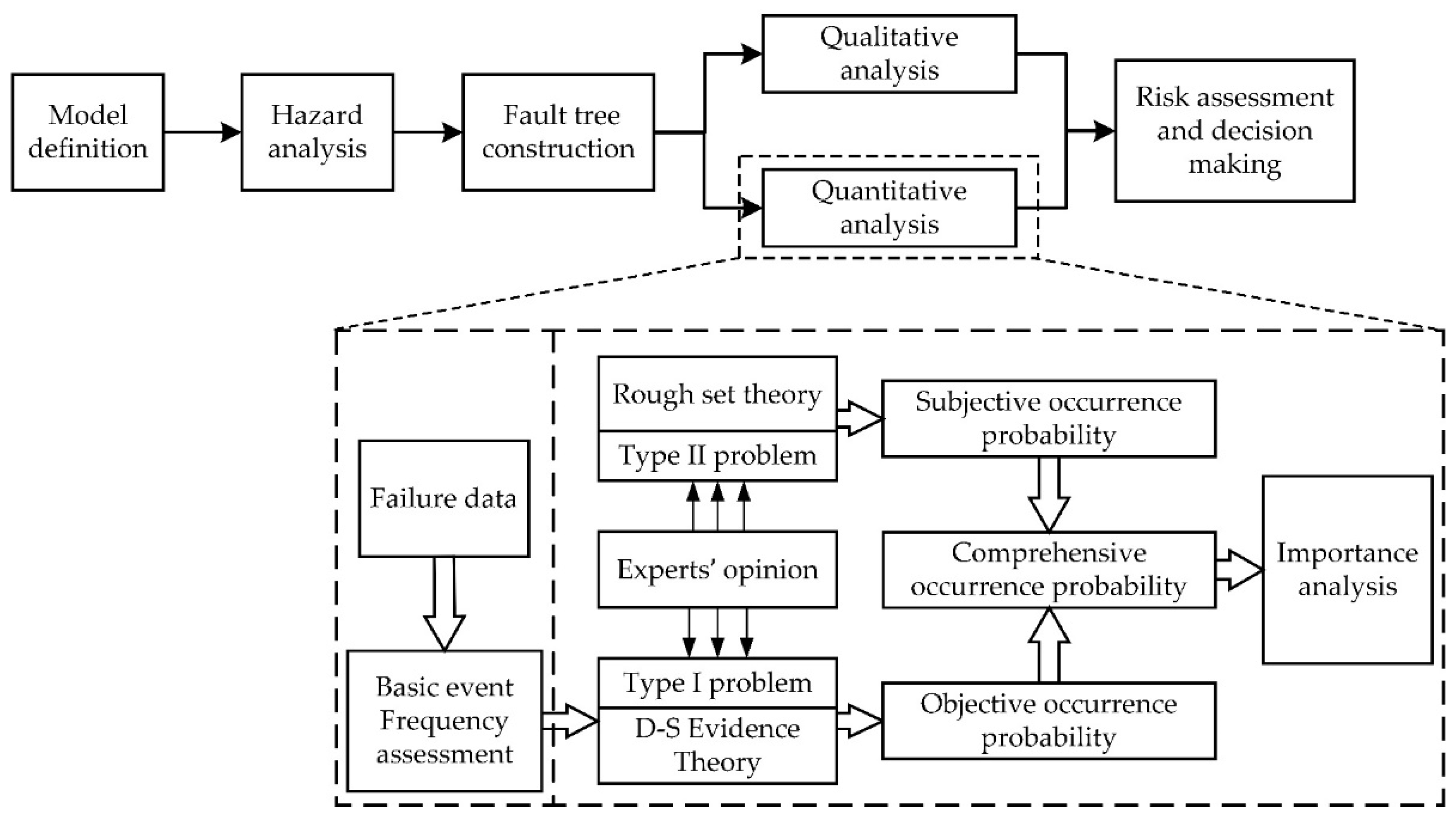

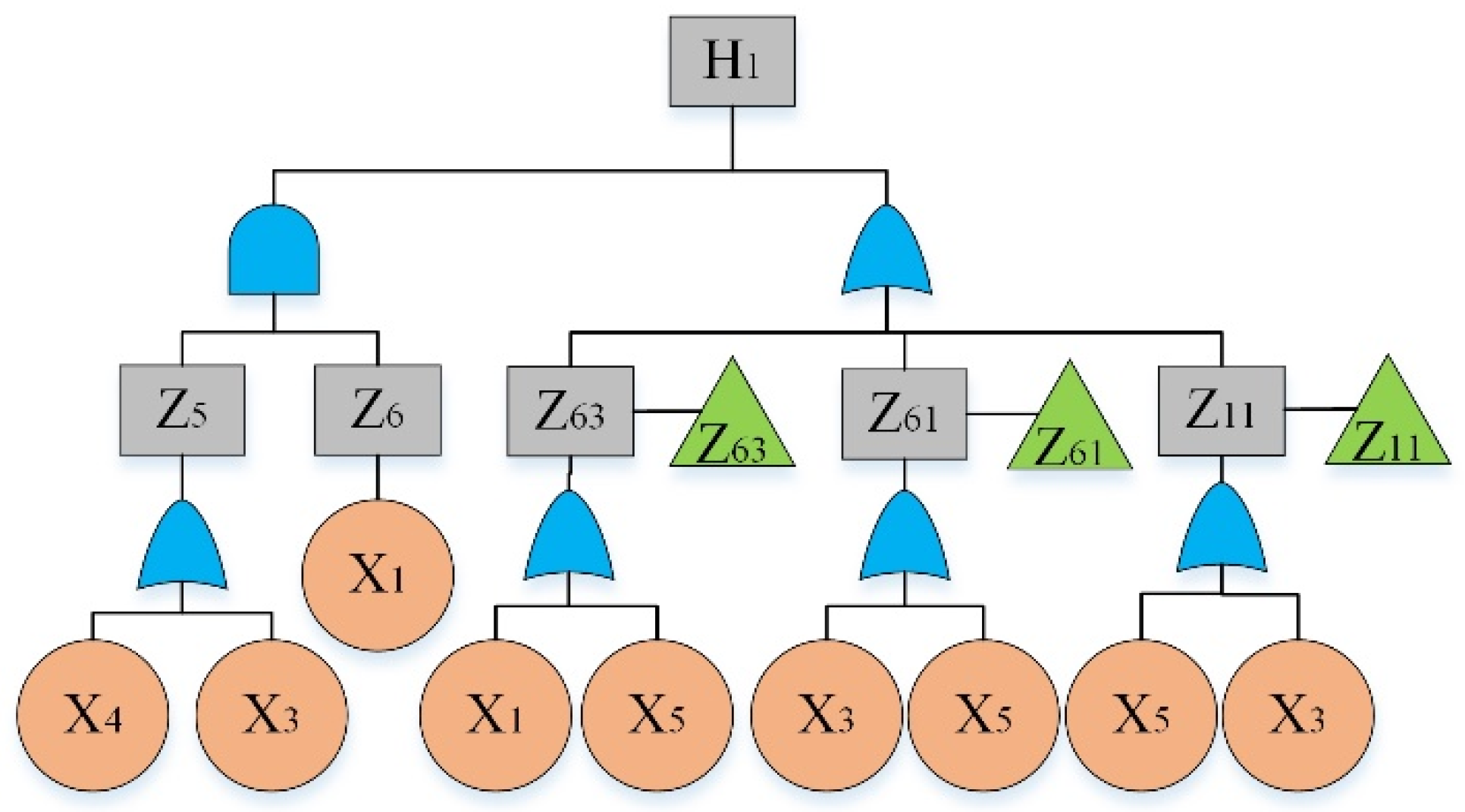
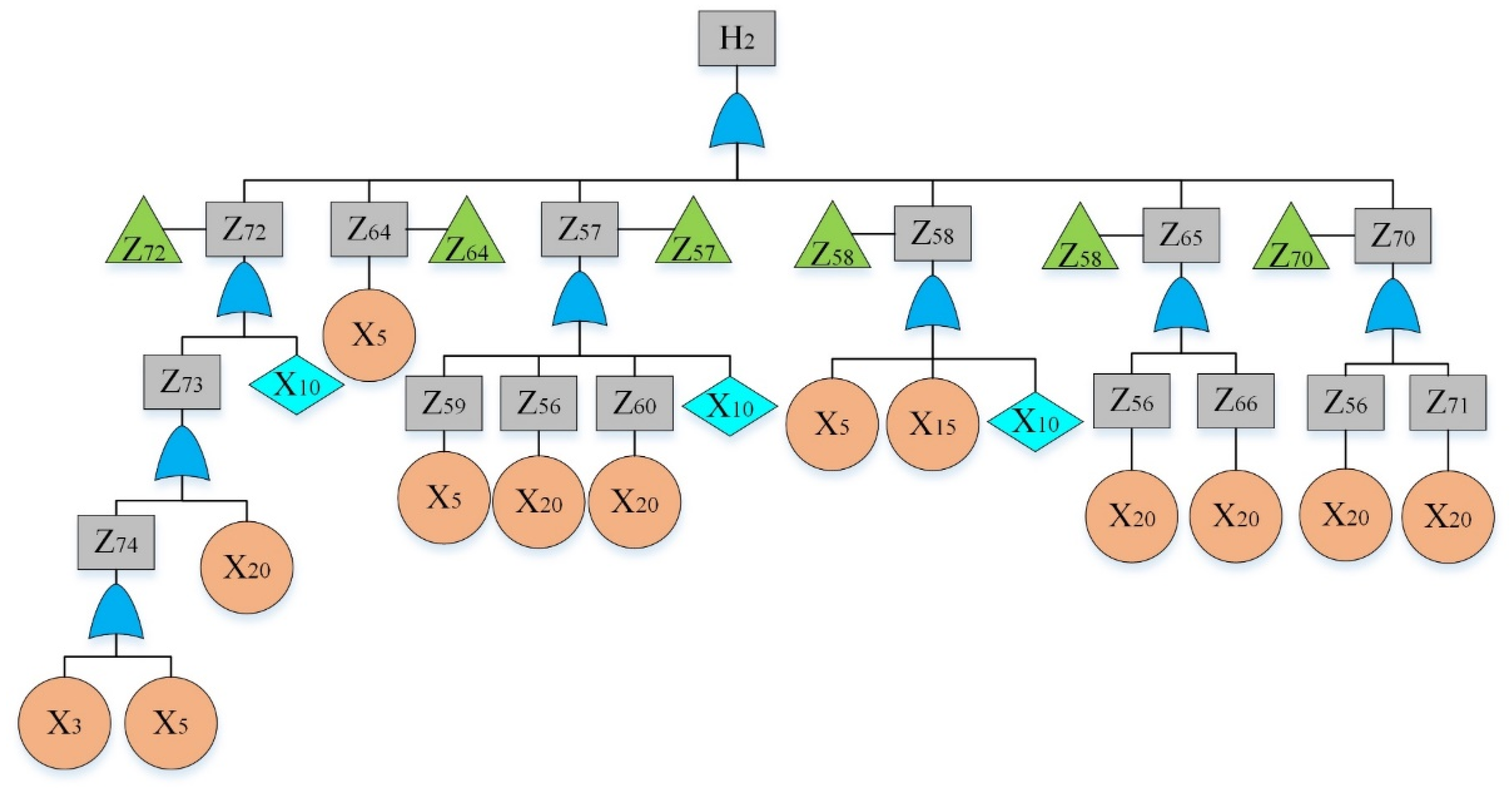
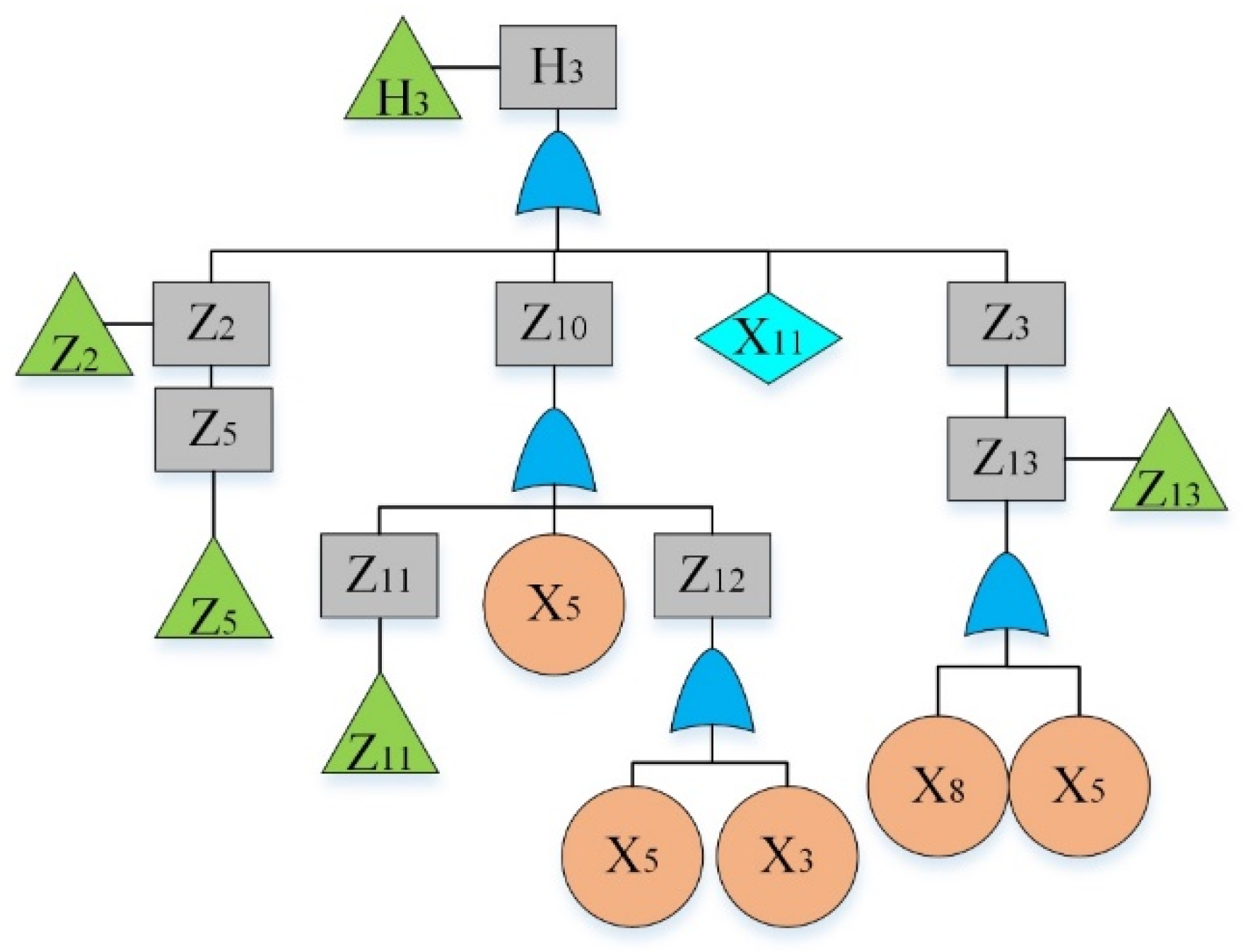
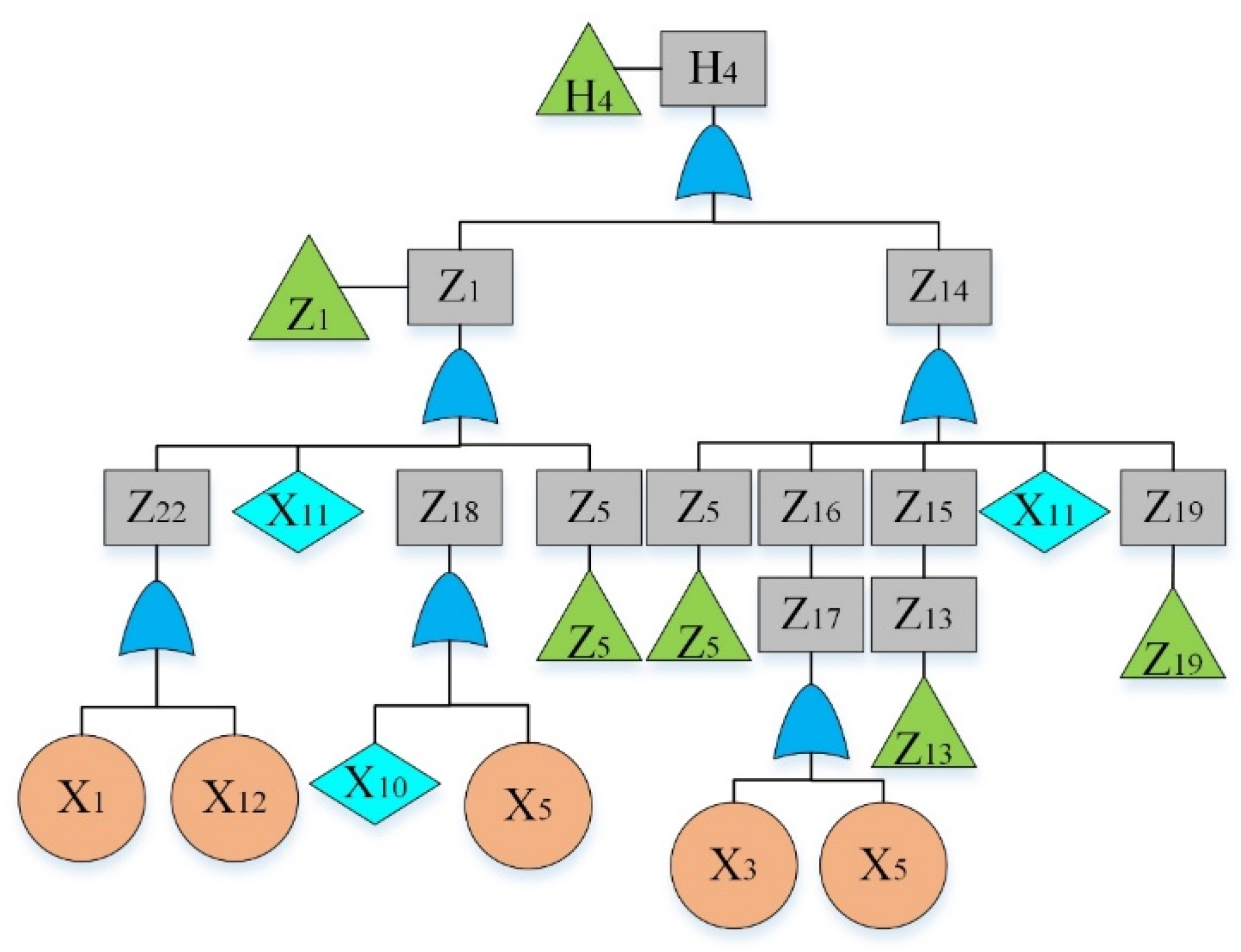
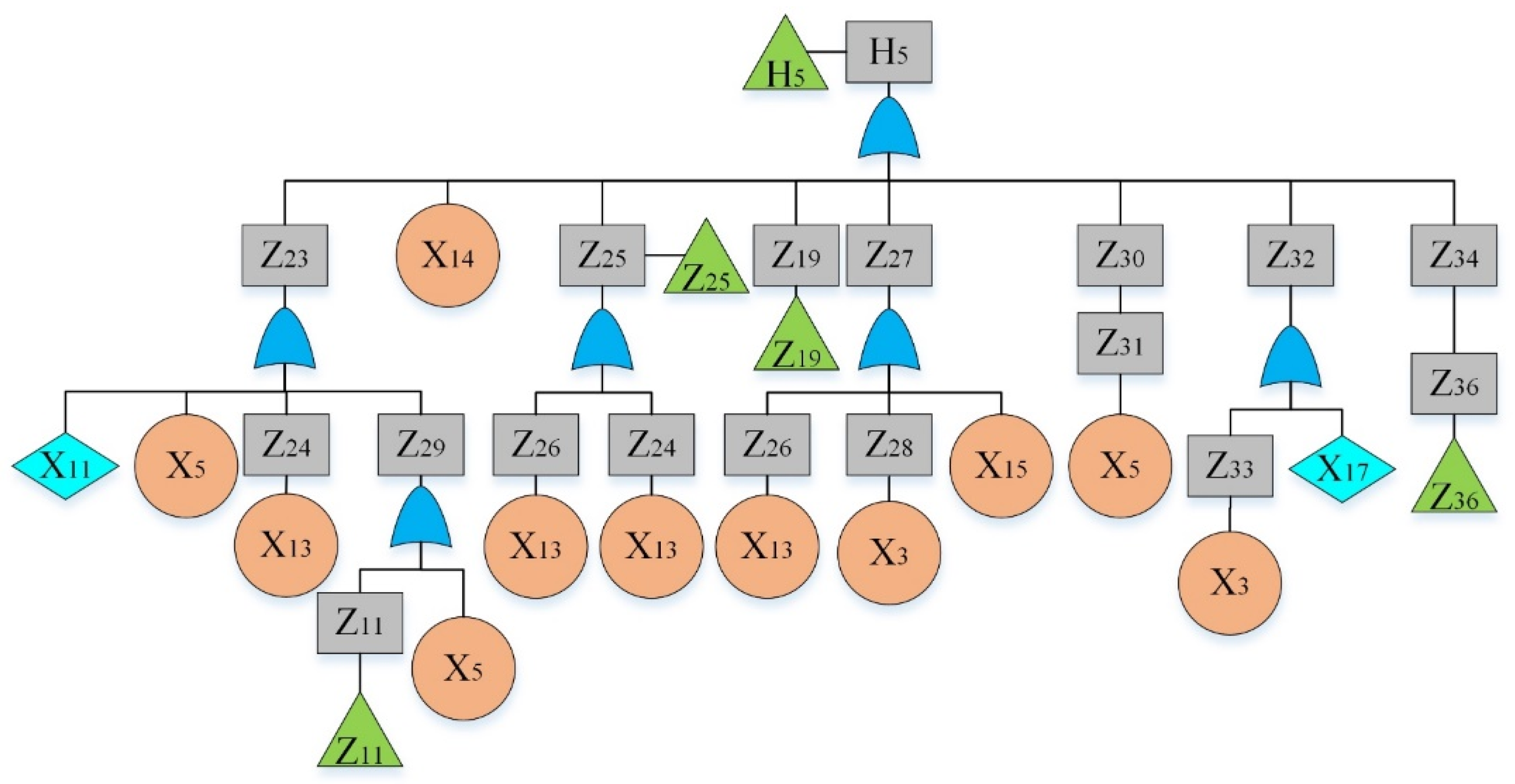
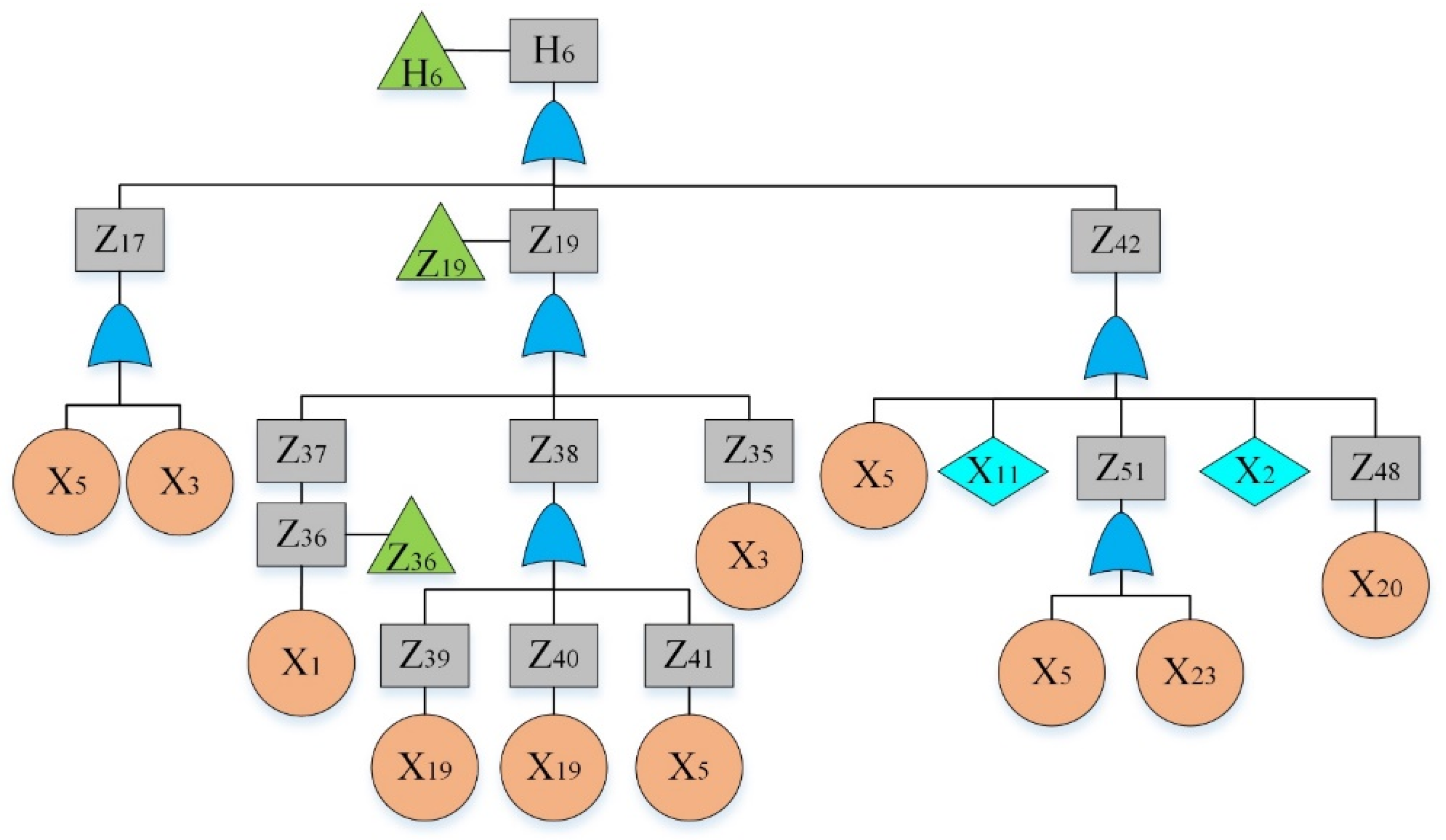

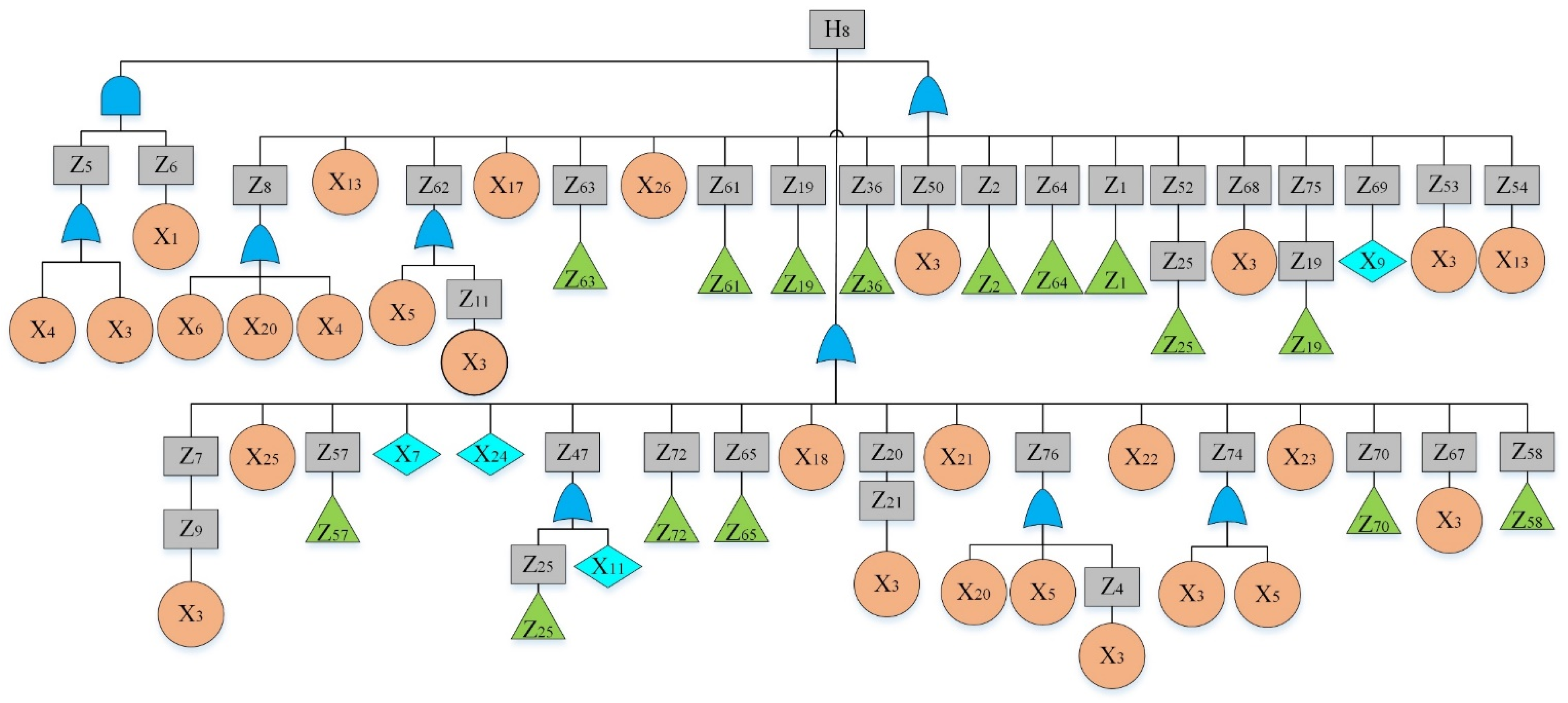
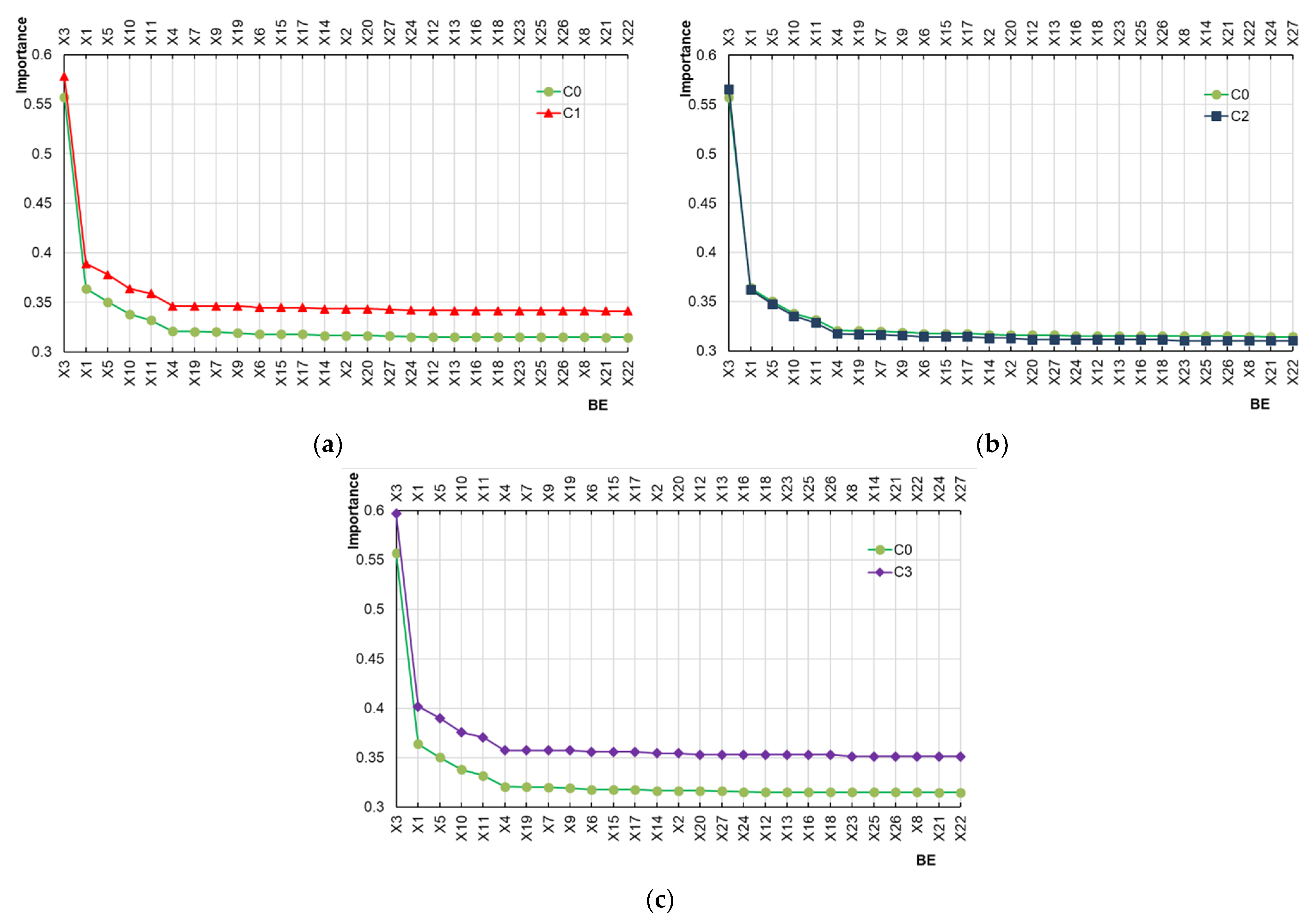
| Focal Element | Expert E1 | Expert E2 | … | Expert Em |
|---|---|---|---|---|
| A1 | M1(A1) | M2(A1) | … | Mm(A1) |
| A2 | M1(A2) | M2(A2) | … | Mm(A2) |
| … | … | … | … | |
| An | M1(An) | M2(An) | … | Mm(An) |
| Combination | D1 | D2 | … | Ds |
|---|---|---|---|---|
| Frequency interval | [Bel(D1), Pl(D1)] | [Bel(D2), Pl(D2)] | … | [Bel(Ds), Pl(Ds)] |
| BE | Designers F1 | Maintainers F2 | Users F3 |
|---|---|---|---|
| T1 | ξ11 | ξ12 | ξ13 |
| T2 | ξ21 | ξ22 | ξ23 |
| … | … | … | … |
| Tp | ξp1 | ξp2 | ξp3 |
| Code | Failure Mode | Code | Failure Mode |
|---|---|---|---|
| H1 | Oil passage blocked | H5 | Oil temperature too high |
| H2 | Leakage | H6 | Too much noise |
| H3 | Insufficient or fluctuating flow | H7 | Heavy vibration |
| H4 | Insufficient or fluctuating pressure | H8 | Hydraulic elements fault |
| Symbol | Meaning | Symbol | Meaning |
|---|---|---|---|
 | Top event |  | AND gate |
 | Intermediate event |  | OR gate |
 | Basic event |  | Transfer-in |
 | Undeveloped event |  | Transfer-out |
| Event | Content | Event | Content |
|---|---|---|---|
| Z1 | Lack of pressure | Z53 | Impurity interference |
| Z2 | Lack or fluctuation of oil flow in filter | Z54 | Improper set value of sensor |
| Z3 | Pump Flow unstable | Z55 | Seal wear |
| Z4 | Impurity entry the execute component | Z56 | Poor sealing |
| Z5 | Deposition of contaminants in filter | Z57 | Pipe joint leakage |
| Z6 | Filter not replaced or cleaned | Z58 | Pipe leakage |
| Z7 | Filter element damage | Z59 | Poor pipe joint quality |
| Z8 | Bypass leakage of filter too much | Z60 | Pipe joints loose |
| Z9 | Impact of oil contamination | Z61 | Pipe wear |
| Z10 | Lack or fluctuation of oil flow in the valve | Z62 | Oversize gap between the throttle valve body and spool |
| Z11 | Valve wear | Z63 | Pipes bending deformation |
| Z12 | Valve rust | Z64 | Valve Leakage |
| Z13 | Pump unstable | Z65 | Junction between the valve and pipe leakage |
| Z14 | Fluctuation of oil flow | Z66 | Junction between the valve and pipe loose |
| Z15 | Oil pressure of the pump unstable | Z67 | Impurity entry to the throttle valve |
| Z16 | The pump–outlet pressure unstable | Z68 | Flow area of the throttle too small |
| Z17 | Internal pump wear | Z69 | Throttle position change |
| Z18 | Insufficient pump oil pressure | Z70 | Hydraulic actuator junction leakage |
| Z19 | Air gets into the pump | Z71 | Junction of actuator loose |
| Z20 | The movement of the valve core of the overflow valve not sensitive | Z72 | Actuator leakage |
| Z21 | Impurity entry to the overflow valve | Z73 | Internal clearance in actuator too large |
| Z22 | Oil starvation in tank | Z74 | Internal wear in actuator |
| Z23 | Inside leakage | Z75 | Air into the actuator |
| Z24 | Pressure set of the relief valve too large | Z76 | Actuator gets stuck |
| Z25 | Improper pressure setting | X1 | Improper maintenance |
| Z26 | Pressure setting of the back pressure valve too large | X2 | Rotors of motor loose |
| Z27 | Oil return resistance too large | X3 | Oil pollution |
| Z28 | Oil discharge filter plug | X4 | Wrong choice of filter |
| Z29 | Valve gap too large | X5 | Outsourced parts fault |
| Z30 | Excessive friction between hydraulic elements | X6 | Poor processing quality of parts |
| Z31 | Valve gap too narrow | X7 | Other mechanical faults |
| Z32 | Poor heat dissipation | X8 | Motor supply voltage not stable |
| Z33 | Deposition of contaminants in heatsink | X9 | Vibration of mechanical system too heavy |
| Z34 | Insufficient circulating oil | X10 | Product damage |
| Z35 | Plugged oil inlet | X11 | Excessive oil viscosity |
| Z36 | Low oil level | X12 | Tank leakage |
| Z37 | Filter above oil level | X13 | Parameter setting error |
| Z38 | Suction line leakage | X14 | Wrong choice of oil |
| Z39 | Suction line loose | X15 | Piping delaminating |
| Z40 | Suction line damaged | X16 | Oil viscosity too low |
| Z41 | Suction line seal damaged | X17 | Radiator failure |
| Z42 | Hydraulic station too loud | X18 | Material aging |
| Z43 | Vibration of hydraulic station too heavy | X19 | Pipeline is not fixed |
| Z44 | Fixing bolt of motor is loose | X20 | Improper assembly |
| Z45 | Coupling loose between the motor and pump | X21 | Motor power fault |
| Z46 | Bubbles generate in the oil | X22 | Motor supply voltage too low |
| Z47 | Pump load too heavy | X23 | Motor bearings not sufficiently lubricated |
| Z48 | Misalignment of coupling | X24 | Motor rotor stuck |
| Z49 | Excessive motor bearing clearance | X25 | Motor overheating |
| Z50 | The suction line plugs | X26 | Motor supply voltage too high |
| Z51 | Motor bearing wear | X27 | Motor rotor unbalanced |
| Z52 | The pressure gauge over range |
| BE | Frequency | BE | Frequency | BE | Frequency |
|---|---|---|---|---|---|
| X1 | 29 | X10 | 15 | X19 | 4 |
| X2 | 2 | X11 | 12 | X20 | 2 |
| X3 | 95 | X12 | 1 | X23 | 1 |
| X4 | 4 | X13 | 1 | X25 | 1 |
| X5 | 23 | X15 | 3 | X26 | 1 |
| X6 | 3 | X16 | 1 | Uncertain | 21 |
| X7 | 4 | X17 | 3 | ||
| X9 | 4 | X18 | 1 |
| Combination | M1 | M2 | M |
|---|---|---|---|
| {D1} | 0.6 | 0.7 | 0.859 |
| {D2} | 0.15 | 0.15 | 0.043 |
| {D3} | 0.15 | 0.15 | 0.082 |
| {D1, D2, D3} | 0.1 | 0.1 | 0.016 |
| BE | D1 | D2 | D3 |
|---|---|---|---|
| Confidence interval | [0.859,0.875] | [0.043,0.059] | [0.082,0.098] |
| BE | Designers F1 | Maintainers F2 | Users F3 |
|---|---|---|---|
| X8 | ([0.003, 0.005], [0.002, 0.008]) | ([0.002, 0.004], [0.002, 0.005]) | ([0.003, 0.004], [0.003, 0.007]) |
| X14 | ([0.008, 0.012], [0.005, 0.015]) | ([0.007, 0.011], [0.004, 0.012]) | ([0.007, 0.012], [0.005, 0.014]) |
| X21 | ([0.002, 0.004], [0.001, 0.005]) | ([0.002, 0.004], [0.002, 0.005]) | ([0.003, 0.004], [0.002, 0.006]) |
| X22 | ([0.003, 0.005], [0.002, 0.008]) | ([0.001, 0.004], [0.001, 0.005]) | ([0.002, 0.003], [0.001, 0.004]) |
| X24 | ([0.004, 0.006], [0.003, 0.008]) | ([0.005, 0.006], [0.004, 0.007]) | ([0.003, 0.005], [0.003, 0.008]) |
| X27 | ([0.007, 0.009], [0.005, 0.013]) | ([0.006, 0.008], [0.005, 0.011]) | ([0.008, 0.009], [0.006, 0.011]) |
| BE | Designers F1 | Maintainers F2 | Users F3 | ||||||
|---|---|---|---|---|---|---|---|---|---|
| Preference Distance | Preference Distance | Preference Distance | |||||||
| X8 | 0.006 | 0.002 | 0.003 | 0.006 | 0.001 | 0.002 | 0.006 | 0.002 | 0.003 |
| X14 | 0 | 0.007 | 0.005 | 0.001 | 0.006 | 0.004 | 0.001 | 0.007 | 0.005 |
| X21 | 0.007 | 0 | 0.002 | 0.006 | 0.001 | 0.002 | 0.007 | 0.001 | 0.003 |
| X22 | 0.006 | 0.002 | 0.003 | 0.006 | 0 | 0.002 | 0.008 | 0 | 0.002 |
| X24 | 0.005 | 0.002 | 0.003 | 0.004 | 0.003 | 0.003 | 0.005 | 0.003 | 0.003 |
| X27 | 0.002 | 0.006 | 0.005 | 0.002 | 0.005 | 0.004 | 0.002 | 0.006 | 0.005 |
| Index | F1 | F2 | F3 |
|---|---|---|---|
| ej | 0.977 | 0.973 | 0.975 |
| wj | 0.311 | 0.364 | 0.325 |
| BE | Utility Value | Expectation |
|---|---|---|
| X8 | ([0.003, 0.004], [0.002, 0.007]) | 0.004 |
| X14 | ([0.007, 0.012], [0.005, 0.014]) | 0.009 |
| X21 | ([0.002, 0.004], [0.002, 0.005]) | 0.003 |
| X22 | ([0.002, 0.004], [0.001, 0.006]) | 0.003 |
| X24 | ([0.004, 0.006], [0.003, 0.008]) | 0.005 |
| X27 | ([0.007, 0.009], [0.005, 0.012]) | 0.008 |
| Basic Event | Frequency | Objective Occurrence | Subjective Occurrence | Comprehensive Occurrence | Expectation |
|---|---|---|---|---|---|
| X1 | [32.752, 33.128] | [0.142, 0.143] | 0 | [0.137, 0.139] | 0.138 |
| X2 | [2, 2] | [0.009, 0.009] | 0 | [0.008, 0.008] | 0.008 |
| X3 | [103.951, 104.541] | [0.450, 0.453] | 0 | [0.434, 0.440] | 0.437 |
| X4 | [5.127, 5.225] | [0.022, 0.023] | 0 | [0.021, 0.022] | 0.022 |
| X5 | [24.896, 25.058] | [0.108, 0.108] | 0 | [0.104, 0.105] | 0.105 |
| X6 | [3, 3] | [0.013, 0.013] | 0 | [0.013, 0.013] | 0.013 |
| X7 | [4.657, 4.802] | [0.020, 0.021] | 0 | [0.019, 0.020] | 0.020 |
| X8 | 0 | 0 | 0.004 | [0.004, 0.004] | 0.004 |
| X9 | [4, 4] | [0.017, 0.017] | 0 | [0.017, 0.017] | 0.017 |
| X10 | [17.112, 17.308] | [0.074, 0.075] | 0 | [0.071, 0.073] | 0.072 |
| X11 | [12.989, 13] | [0.056, 0.056] | 0 | [0.054, 0.055] | 0.054 |
| X12 | [1, 1] | [0.004, 0.004] | 0 | [0.004, 0.004] | 0.004 |
| X13 | [1, 1] | [0.004, 0.004] | 0 | [0.004, 0.004] | 0.004 |
| X14 | 0 | 0 | 0.009 | [0.009, 0.009] | 0.009 |
| X15 | [3, 3] | [0.013, 0.013] | 0 | [0.013, 0.013] | 0.013 |
| X16 | [1, 1] | [0.004, 0.004] | 0 | [0.004, 0.004] | 0.004 |
| X17 | [3, 3] | [0.013, 0.013] | 0 | [0.013, 0.013] | 0.013 |
| X18 | [1, 1] | [0.004, 0.004] | [0.004, 0.004] | 0.004 | |
| X19 | [4.866, 4.991] | [0.021, 0.022] | 0 | [0.020, 0.021] | 0.021 |
| X20 | [2, 2] | [0.009, 0.009] | 0 | [0.008, 0.008] | 0.008 |
| X21 | 0 | 0 | 0.003 | [0.003, 0.003] | 0.003 |
| X22 | 0 | 0 | 0.003 | [0.003, 0.003] | 0.003 |
| X23 | [1, 1] | [0.004, 0.004] | 0 | [0.004, 0.004] | 0.004 |
| X24 | 0 | 0 | 0.005 | [0.005, 0.005] | 0.005 |
| X25 | [1, 1] | [0.004, 0.004] | 0 | [0.004, 0.004] | 0.004 |
| X26 | [1, 1] | [0.004, 0.004] | 0 | [0.004, 0.004] | 0.004 |
| X27 | 0 | 0 | 0.008 | [0.008, 0.008] | 0.008 |
| BE | Index | BE | Index | BE | Index |
|---|---|---|---|---|---|
| X1 | [0.3609, 0.3669] | X10 | [0.3350, 0.3411] | X19 | [0.3173, 0.3233] |
| X2 | [0.3133, 0.3194] | X11 | [0.3286, 0.3349] | X20 | [0.3133, 0.3194] |
| X3 | [0.5545, 0.5597] | X12 | [0.3120, 0.3181] | X21 | [0.3116, 0.3176] |
| X4 | [0.3176, 0.3237] | X13 | [0.3120, 0.3181] | X22 | [0.3116, 0.3176] |
| X5 | [0.3473, 0.3535] | X14 | [0.3134, 0.3195] | X23 | [0.3120, 0.3181] |
| X6 | [0.3146, 0.3207] | X15 | [0.3146, 0.3207] | X24 | [0.3122, 0.3183] |
| X7 | [0.3171, 0.3230] | X16 | [0.3120, 0.3181] | X25 | [0.3120, 0.3181] |
| X8 | [0.3119, 0.3180] | X17 | [0.3146, 0.3207] | X26 | [0.3120, 0.3181] |
| X9 | [0.3160, 0.3221] | X18 | [0.3120, 0.3181] | X27 | [0.3131, 0.3192] |
| BE | Index | BE | Index | BE | Index |
|---|---|---|---|---|---|
| X1 | 0.363929987 | X10 | 0.338072619 | X19 | 0.320304036 |
| X2 | 0.316339954 | X11 | 0.331756299 | X20 | 0.316339954 |
| X3 | 0.557089359 | X12 | 0.315008549 | X21 | 0.314602054 |
| X4 | 0.320643759 | X13 | 0.315008549 | X22 | 0.314602054 |
| X5 | 0.350364665 | X14 | 0.316445615 | X23 | 0.315008549 |
| X6 | 0.317682661 | X15 | 0.317682661 | X24 | 0.315214182 |
| X7 | 0.320031414 | X16 | 0.315008549 | X25 | 0.315008549 |
| X8 | 0.314907821 | X17 | 0.317682661 | X26 | 0.315008549 |
| X9 | 0.319036815 | X18 | 0.315008549 | X27 | 0.316136855 |
Publisher’s Note: MDPI stays neutral with regard to jurisdictional claims in published maps and institutional affiliations. |
© 2021 by the authors. Licensee MDPI, Basel, Switzerland. This article is an open access article distributed under the terms and conditions of the Creative Commons Attribution (CC BY) license (http://creativecommons.org/licenses/by/4.0/).
Share and Cite
Li, S.; Yang, Z.; Tian, H.; Chen, C.; Zhu, Y.; Deng, F.; Lu, S. Failure Analysis for Hydraulic System of Heavy-Duty Machine Tool with Incomplete Failure Data. Appl. Sci. 2021, 11, 1249. https://doi.org/10.3390/app11031249
Li S, Yang Z, Tian H, Chen C, Zhu Y, Deng F, Lu S. Failure Analysis for Hydraulic System of Heavy-Duty Machine Tool with Incomplete Failure Data. Applied Sciences. 2021; 11(3):1249. https://doi.org/10.3390/app11031249
Chicago/Turabian StyleLi, Shizheng, Zhaojun Yang, Hailong Tian, Chuanhai Chen, Yongfu Zhu, Fuqin Deng, and Song Lu. 2021. "Failure Analysis for Hydraulic System of Heavy-Duty Machine Tool with Incomplete Failure Data" Applied Sciences 11, no. 3: 1249. https://doi.org/10.3390/app11031249
APA StyleLi, S., Yang, Z., Tian, H., Chen, C., Zhu, Y., Deng, F., & Lu, S. (2021). Failure Analysis for Hydraulic System of Heavy-Duty Machine Tool with Incomplete Failure Data. Applied Sciences, 11(3), 1249. https://doi.org/10.3390/app11031249






